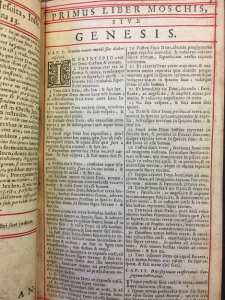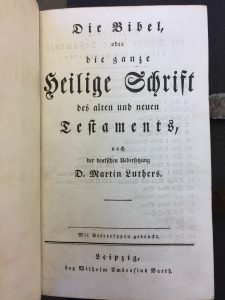As I research the two bibles, the Biblia Sacra and the Die Bibel, one thing I have come to realize is that context is the first step to understanding them. Despite these bibles having almost all of the necessary descriptive qualities to help us understand where it comes from, such as the title, date and place of publishing, and who translated them, it has been made difficult to discern exact qualities by the fact that they are entirely in Latin (Biblia Sacra) and German (Die Bibel, though this also has some Latin at the beginning prior to Genesis). With my very minimal knowledge of Latin and almost no knowledge of German, it was initially tough for me to analyze these bibles, a challenge I had known I would face but did not fully realize until I had begun my research.

First page of Genesis
The Biblia Sacra’s full name is Biblia Sacra sive testamentum vitus, Ab. Im. Tremellio et Fr. Ivnio ex Hebraeo Latine redditum. Et Tes Testamentum Novum, a Theod. Beza e Graeco in Latinum verfum. The good thing about reading Latin is that English is based on it, so there are many recognizable words. For example, “Biblia Sacra” can easily be discerned as “Sacred Bible,” or “Holy Bible.” The next most easily recognizable is “testamentum,” or “testament.” The rest was difficult to piece together due to the lack of reliable internet translations and ambiguous Latin definitions, but from my understanding, it essentially explains that the Old Testament was translated out of the original Hebrew into Latin by Tremellio and Father Ivnio and the New Testament was translated from Greek to Latin by Theodore Beza. I previously stated in my last blog post that this bible was published in Amsterdam in 1669. Roman numerals can be easy to understand, but once you get into the thousands, it gets a little tricky. Luckily, we covered Roman numerals in class, so understanding MDCLXIX written on the title page as 1669 made it easy to recognize the date of publishing. This amount of thought on the title page alone was enough to prove to me that the first step to being able to effectively write about these bibles was that I really needed to be able to understand them in an English translation.

Title page
The Die Bibel’s title is Die Bibel, oder die ganze Heilig Schrift des alten und neuen Teftaments, nach der deutfchen Ueberfebung D. Martin Luthers. This was more difficult to translate without looking anything up, as the only words I recognized were “neuen Testament” meaning “New Testament” and the name Martin Luther. Another element to the challenge was that the Gothic script sometimes made it hard to not only discern what each letter was, but also what words they were forming. After a quick translation, it can be understood to mean, “The Bible, or the whole Holy Scriptures of the Old and New Testaments, after the German translation of Martin Luther.” This bible does not have a date of publication anywhere, so it can be tricky to date it. However, knowing that it was translated by Martin Luther helps figure out when it could have been published. Martin Luther published the first translations of the entire Bible from Hebrew and ancient Greek in 1534, which means that this is the earliest date it could possibly have been published. Martin Luther published his translation because he believed that the Latin Vulgate, the bible that had been used by the Catholic Church for a thousand years at that point, was out of date. This was just one of 95 qualms he had with the Catholic Church, so this book can be viewed as a Protestant bible.